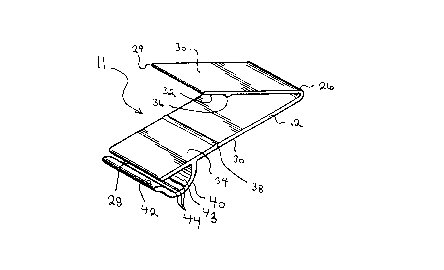Some of the information on this Web page has been provided by external sources. The Government of Canada is not responsible for the accuracy, reliability or currency of the information supplied by external sources. Users wishing to rely upon this information should consult directly with the source of the information. Content provided by external sources is not subject to official languages, privacy and accessibility requirements.
Any discrepancies in the text and image of the Claims and Abstract are due to differing posting times. Text of the Claims and Abstract are posted:
| (12) Patent: | (11) CA 2087377 |
|---|---|
| (54) English Title: | METHOD OF AND APPARATUS FOR SUSPENDING CHRISTMAS LIGHTS FROM EAVES ON A HOUSE |
| (54) French Title: | METHODE ET DISPOSITIF POUR SUSPENDRE DES LUMIERES DE NOEL AUX DEBORDS DE TOIT |
| Status: | Term Expired - Post Grant Beyond Limit |
| (51) International Patent Classification (IPC): |
|
|---|---|
| (72) Inventors : |
|
| (73) Owners : |
|
| (71) Applicants : | |
| (74) Agent: | |
| (74) Associate agent: | |
| (45) Issued: | 1998-03-31 |
| (22) Filed Date: | 1993-01-15 |
| (41) Open to Public Inspection: | 1994-07-16 |
| Examination requested: | 1995-01-24 |
| Availability of licence: | N/A |
| Dedicated to the Public: | N/A |
| (25) Language of filing: | English |
| Patent Cooperation Treaty (PCT): | No |
|---|
| (30) Application Priority Data: | None |
|---|
A method of suspending christmas lights from eaves of a
house finished with aluminum or vinyl soffit panels and facia.
Firstly, attach a plurality of wedge shaped members to a string
of christmas lights. Secondly, insert the wedge shaped members
between facia and soffit of a house. The christmas lights
protrude perpendicularly below the facia and are clearly
visible from an adjacent street while the wedge shaped members
and light cord remain substantially hidden from view by the
facia.
Note: Claims are shown in the official language in which they were submitted.
Note: Descriptions are shown in the official language in which they were submitted.

2024-08-01:As part of the Next Generation Patents (NGP) transition, the Canadian Patents Database (CPD) now contains a more detailed Event History, which replicates the Event Log of our new back-office solution.
Please note that "Inactive:" events refers to events no longer in use in our new back-office solution.
For a clearer understanding of the status of the application/patent presented on this page, the site Disclaimer , as well as the definitions for Patent , Event History , Maintenance Fee and Payment History should be consulted.
| Description | Date |
|---|---|
| Inactive: IPC deactivated | 2016-01-16 |
| Inactive: IPC assigned | 2016-01-01 |
| Inactive: IPC expired | 2016-01-01 |
| Inactive: IPC removed | 2015-12-17 |
| Inactive: IPC removed | 2015-12-16 |
| Inactive: IPC assigned | 2015-12-16 |
| Inactive: First IPC assigned | 2015-12-16 |
| Inactive: IPC removed | 2015-12-16 |
| Inactive: IPC removed | 2015-12-16 |
| Inactive: IPC assigned | 2015-12-16 |
| Inactive: IPC assigned | 2015-12-16 |
| Inactive: Expired (new Act pat) | 2013-01-15 |
| Inactive: IPC from MCD | 2006-03-11 |
| Inactive: IPC from MCD | 2006-03-11 |
| Inactive: IPC from MCD | 2006-03-11 |
| Grant by Issuance | 1998-03-31 |
| Inactive: Office letter | 1998-01-20 |
| Inactive: Office letter | 1998-01-20 |
| Inactive: Delete abandonment | 1998-01-20 |
| Deemed Abandoned - Conditions for Grant Determined Not Compliant | 1997-08-11 |
| Pre-grant | 1997-06-23 |
| Notice of Allowance is Issued | 1997-02-11 |
| Request for Examination Requirements Determined Compliant | 1995-01-24 |
| All Requirements for Examination Determined Compliant | 1995-01-24 |
| Application Published (Open to Public Inspection) | 1994-07-16 |
| Small Entity Declaration Determined Compliant | 1993-01-15 |
| Abandonment Date | Reason | Reinstatement Date |
|---|---|---|
| 1997-08-11 |
The last payment was received on 1998-01-20
Note : If the full payment has not been received on or before the date indicated, a further fee may be required which may be one of the following
Please refer to the CIPO Patent Fees web page to see all current fee amounts.
| Fee Type | Anniversary Year | Due Date | Paid Date |
|---|---|---|---|
| Final fee - small | 1997-06-23 | ||
| Reinstatement | 1997-06-23 | ||
| MF (application, 8th anniv.) - small | 08 | 2001-01-15 | 1998-01-20 |
| MF (application, 5th anniv.) - small | 05 | 1998-01-20 | 1998-01-20 |
| MF (application, 7th anniv.) - small | 07 | 2000-01-17 | 1998-01-20 |
| MF (application, 9th anniv.) - small | 09 | 2002-01-15 | 1998-01-20 |
| MF (application, 6th anniv.) - small | 06 | 1999-01-15 | 1998-01-20 |
| MF (patent, 10th anniv.) - small | 2003-01-15 | 2003-01-13 | |
| MF (patent, 11th anniv.) - small | 2004-01-15 | 2004-01-06 | |
| MF (patent, 12th anniv.) - small | 2005-01-17 | 2004-01-06 | |
| MF (patent, 14th anniv.) - small | 2007-01-15 | 2004-01-06 | |
| MF (patent, 13th anniv.) - small | 2006-01-16 | 2004-01-06 | |
| MF (patent, 15th anniv.) - small | 2008-01-15 | 2008-01-08 | |
| MF (patent, 16th anniv.) - small | 2009-01-15 | 2009-01-15 | |
| MF (patent, 17th anniv.) - small | 2010-01-15 | 2010-01-13 | |
| MF (patent, 18th anniv.) - small | 2011-01-17 | 2011-01-11 | |
| MF (patent, 19th anniv.) - small | 2012-01-16 | 2012-01-13 |
Note: Records showing the ownership history in alphabetical order.
| Current Owners on Record |
|---|
| WILLIAM BRIAN DOUGAN |
| MURRAY R. NESBITT |
| Past Owners on Record |
|---|
| None |